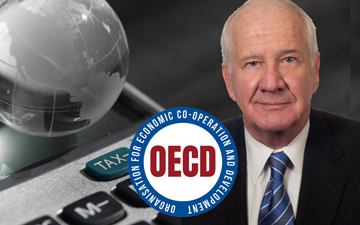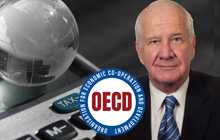The OECD corporate minimum tax: a disaster in the making

Allan Lanthier says it's time for accounting firms, bodies and industry groups to challenge the flaws in the OECD global corporate minimum tax plan
MONTREAL – On December 20, 2021, the OECD issued model rules for its 15 percent global corporate minimum tax — the so-called Pillar Two.[1] It is a brutally complex 70-page package that includes some significant changes to the October 2021 OECD framework.
After giving a brief overview of Pillar Two and where things stand today, this article discusses some of the key concepts and how they might apply in practice. The article then summarizes the reasons why this misguided initiative should be abandoned, and concludes with comments on some of the challenges the accounting profession will face if it is not.
Overview of Pillar Two
The rules apply to multinational groups with annual gross revenue of at least € 750 million (approximately C $1 billion), and to all entities that are included in the consolidated financial statements for that group. Close to 140 countries agreed to the October 2021 framework, but not to these model rules. Nonetheless, it seems that political decisions have been made by many countries to proceed, with an effective date as early as 2023.[2]
Last week, the OECD issued 277 pages of commentary and examples for the model rules. It will take some time to digest and analyze this material. Meanwhile, a number of countries, including Canada, have already started drafting legislation to incorporate the rules as part of domestic law.
Under the rules, a Canadian parent company with foreign subsidiaries that are paying tax at a rate of less than 15 percent in any particular country will owe a “top-up” tax to make up the difference. Sounds simple enough. Unfortunately, the model rules are anything but. Some of the key concepts are outlined below. Warning: the commentary that follows deals with convoluted subject matter; reader discretion is advised.
The computation of income
In what I would argue is the first error, income will not be computed in accordance with new tax rules: instead income will be based on accounting earnings for each entity, using the accounting standard of the Ultimate Parent Entity (UPE). If the UPE is in Canada, that standard will be IFRS.[3]
Why is it an error to base the tax on accounting standards? First, accounting standards serve a very different purpose than tax rules. A primary purpose of the former is to comply with financial securities law and inform stakeholders about the risks and benefits of investing in or lending to a firm: tax rules define a tax base using specific rules that can be administered and enforced. Second, reliance on accounting standards means that governments, including the Parliament of Canada, will in effect cede some of their authority to unelected officials at accounting boards.
Under Pillar Two, accounting income is the starting point for each group entity,[4] and this amount is then subject to many adjustments. The adjustments include: reinstating intragroup transactions that were eliminated on consolidation; by election, substituting accounting expense under stock option arrangements for the tax deduction in the relevant country; reversing pension expense computed under accounting standards and replacing it with the amounts contributed to pension plans for the year; adjusting foreign exchange gains and losses attributable to differences between tax and accounting functional currencies; and removing non-portfolio dividends from income. The list goes on.
These rules must be applied to each entity in the consolidated group, even though some of the accounting entries required to comply with IFRS may have been recorded by the UPE. In these cases, a company will have to dissect and restate consolidated earnings at the entity level even before the numerous required adjustments are identified and applied. In short, what we have is a tax reporting fiasco, with thousands of hours of detailed and tedious work required every year simply to complete this first step.
The computation of taxes
It gets worse. One would have thought that annual taxes (defined as “covered taxes” under the model rules) would simply be cash taxes paid or accrued by the entity for the year in question. It is not.
Again, these rules are based on accounting standards, and the starting point is the amount of current tax expense recorded by the entity for the year. And then the adjustments begin. For example, tax accruals related to uncertain tax positions (UTPs) are reversed and cash payments for UTPs are added; the relevant portions of tax expense recorded in equity or in statements of comprehensive income are added; non-refundable credits such as SR&ED credits in Canada are deducted from tax;[5] and deferred tax balances are revalued at the lower of 15 percent and the applicable tax rate in the relevant jurisdiction, and then annual increases or decreases in deferred tax balances may be relevant, depending on a number of conditions and restrictions. These are only some of the required adjustments.
The jurisdictional top-up tax
The next step is to combine all income and taxes for group entities located in a particular jurisdiction, and compute the effective tax rate (ETR) for that jurisdiction. This is in fact a relatively simple calculation.
If the ETR is below 15 percent in a particular jurisdiction, there will be a residual top-up tax that a group entity will have to pay (which group entity must pay the tax is discussed below). The amount of the required top-up tax is reduced by a “substance-based income exclusion” (SBIE): 5 percent of payroll costs and of the net book value of tangible assets of group entities in that jurisdiction.[6] For example, assume the following:
- Group entities in Country X have combined income of 10,000 and combined tax of 1,200.
- The group’s ETR in Country X is therefore 12 percent.
- The amount of the SBIE in Country X is 1,000.
The amount of the top-up tax for the entities in Country X is 3 percent times [10,000 less 1,000], or 270. The final question is which group entity must pay the tax of 270.
Allocating the top-up tax
The rules for allocating the top-up tax is where things become brutally complex once again.
First, the tax is allocated to group entities under an Income Inclusion Rule (IIR),[7] an odd definition given that top-up tax will simply be allocated to group entities without any income inclusion at all. To the extent that top-up tax cannot be allocated to any group entity (for example, because the countries where those entities are resident have not adopted the rules), the tax will be allocated under an Undertaxed Payment Rule (UTPR), another odd definition: the UTPR has nothing whatever to do with payments.[8]
There are detailed rules prescribing the order in which the IIR is to be applied, rules that are beyond the scope of this article. Suffice it to say that the UPE is not first in line to collect the tax. And so when Finance Minister Chrystia Freeland told CBC News last October that Canada’s share of the Pillar Two pie would be additional annual tax of $3.5 billion, she may have gotten well ahead of herself.
The reasons why Pillar Two should be abandoned
It is time to hit the emergency brake on Pillar Two and for governments to consider a more sensible and balanced approach, and this for four reasons.
First, while politicians are fond of referring to the “race to the bottom,” that race does not actually exist. While corporate tax rates have decreased in many countries over the last several years, these reductions have been accompanied by base-broadening measures. The fact is that, except for the United States, corporate tax has been rising as a percentage of GDP in most countries for almost 50 years.
For example, based on OECD data, Canada’s corporate tax-to-GDP ratio increased by 26 percent from 1972 to 2019. The ratio increased by 10 percent in the same period in the U.K., and by 24 percent in Germany. And for the OECD on average, the increase was a whopping 48 percent.[9]
Second, most issues involving base erosion and profit shifting by large corporate groups have already been addressed by earlier OECD initiatives. In Canada for example, the government has announced that legislation will be introduced to eliminate the tax benefits of hybrid mismatch arrangements, and deny interest expense of a Canadian group that exceeds 30 percent of tax EBITA:[10] draft legislative proposals for the latter have now been released. In addition, Canada has adopted the OECD multilateral instrument (MLI), thereby amending many of our bilateral tax treaties to address treaty shopping and other tax treaty abuses.
Third, applying the rules based on a threshold of annual revenue violates the basic tax policy principles of equity and neutrality. Taxpayers in similar circumstances should bear a similar tax burden. However, under these rules corporate groups that breach the threshold will face additional tax and a massive compliance burden, while somewhat smaller, competing firms will not. As a result, Switzerland has decided that it requires a public referendum approving a constitutional amendment to proceed.
Finally, the rules in Pillar Two are bewilderingly complex, and will be difficult to apply in many situations. In light of the other OECD initiatives that are already in place, Pillar Two should be abandoned and replaced with one simple, additional rule: base-eroding, intragroup payments received by tax haven entities should be taxed under controlled foreign corporation (CFC) regimes, in the case of Canada under our FAPI rules. In Canada, this would involve the repeal of a single provision in our tax code:[11] this instead of 70 pages of model rules and 277 pages of OECD commentary and analysis.
The challenges facing the accounting profession should Pillar Two proceed
The accounting profession will face some daunting challenges should Pillar Two proceed. And in Canada, these challenges will not be limited to a tiny handful of corporate groups.
In 2020, there were more than 300 corporate groups in Canada with annual gross revenue in excess of C $1 billion.[12] While many of these companies will not be within the scope of Pillar Two (crown corporations for example), there are a number of large private corporations which do not release their numbers and therefore are not on this list. In addition, many Canadian subsidiaries of foreign-headquartered groups will be drawn into the melee.
What are the challenges? As discussed above, the model rules require accounting professionals to gather, dissect, analyze and adjust data for each entity in a corporate group, and compute both income and taxes under new OECD rules — an exercise that has never been done before. The compliance costs will be massive: and then the Canada Revenue Agency (CRA) must review and audit the data and calculations. Both taxpayers and the CRA will be learning the rules by trial and error for the next several years.
The income and tax numbers are based on accounting standards, and so the work will largely fall on the shoulders of accounting experts, not tax specialists, although multi-disciplinary teams will certainly be required. Most of the work will be boring and menial, often for the sole purpose of confirming that the ETR for entities in most countries is indeed above 15 percent, except for one or two entities in tax havens.[13]
This is not the type of work that accounting professionals were expecting during their many hours of study for the CPA designation. Thousands of additional hours will be piled on accountants who are already overworked, and the work will be tedious. Morale will suffer, and individuals will resign, both from large corporations and from accounting firms.
I am retired, and am not privy to how accounting firms may be organizing themselves to establish new Pillar Two specialty teams to take on this work. However, I see little evidence that Canadian firms are making the required investments to put these teams in place at this time.
Concluding comment
We have been led down the garden path by unelected bureaucrats at the OECD, supported and emboldened by politicians in many developed countries, including our own.[14] Thus far, the accounting profession has been acquiescent. It is time for accounting firms, accounting bodies and industry groups to speak up, and challenge the serious flaws in Pillar Two.
Footnotes
[1] Pillar One is a separate initiative which, if implemented, will allocate a portion of taxing rights for profits of technology giants such as Apple, Facebook and Google to the market countries where their consumers are located. These rules would only apply to multinational groups with annual gross revenue above € 20 billion (approximately C $28 billion).
[2] The U.K. consultation document issued on January 11, 2022 states that countries that agreed to the framework made a “political commitment” to follow the rules (“OECD Pillar 2: Consultation on implementation”, HM Treasury and HM Revenue & Customs, section 1.25).
[3] Although Accounting Standards for Private Enterprises (ASPE) may apply in some situations if the UPE is not publicly-traded.
[4] The model rules define a “constituent entity” to include a permanent establishment (PE) of a corporation. For example, if a company resident in Country A has PEs in Countries B and C, the corporation has three constituent entities: the calculations of income and taxes must be completed for each such entity, and the results included with the amounts of other entities in determining the group’s effective tax rate for each country.
[5] Non-refundable credits may already reduce tax under accounting standards. Reducing Pillar Two tax by the amount of such credits may decrease the impact of the incentive sought by the country in question. In Canada, certain amounts of SR&ED credits are refundable, but only if earned by Canadian-controlled private corporations.
[6] In 2023, the SBIE will be 10 percent of payroll costs and 8 percent of tangible assets, with these percentages reducing year-by-year over a 10-year period to 5 percent.
[7] Pillar Two will also include a Subject to Tax Rule (STTR), primarily for the benefit of developing countries. The STTR will allow developing countries to levy withholding tax on payments of deductible amounts such as interest and royalties to group entities in low-taxed jurisdictions.
[8] The UTPR allocates top-up tax that has not been captured under the IIR to group entities in adopting countries, based on their relative number of employees and relative book value of tangible assets. In other words, a group entity in a UTPR country may be charged tax on income with which it has no nexus whatever, arguably in violation of many existing tax treaties. Corporations that are assessed tax under the UTPR (or the IIR) in possible violation of tax treaties may well challenge the assessments in court. See “The Pillar Two model rules: a train wreck in the making”, Allan Lanthier, MNE Tax, March 10, 2022.
[9] Ibid, MNE Tax.
[10] Canadian federal budget of April 19, 2021. The interest expense limitation will be 40 percent of tax EBITA in 2023, and 30 percent thereafter.
[11] Namely, subparagraph 95(2)(a)(ii) of the Canadian federal Income Tax Act.
[12] See “FP500: The Premier Ranking of Corporate Canada”, Financial Post Magazine, July 2021.
[13] As discussed, the income of such entities could be dealt with by a simple legislative change to CFC provisions.
[14] Developing countries, on the other hand, will gain little revenue from Pillar Two, and have been considerably less supportive of the initiative.
Allan Lanthier is a retired partner of an international accounting firm, and has been an advisor to both the Department of Finance and the Canada Revenue Agency.







(0) Comments